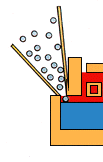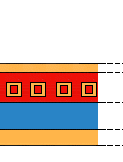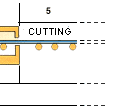Floating
From DDL Wiki
Contents |
Process
(1) Float glass is produced first by forming molten glass from raw materials, such as silica sand, calcium, iron oxide, soda, and magnesium.
(2) These raw materials are heated to approximately 1500 °C within a furnace to form the molten glass.
(3) The molten glass then flows from the furnace onto a pool of molten tin, called a tin bath. The glass does not mix with the molten tin. Under the influence of gravity, the glass slowly flattens until both surfaces are perfectly flat.
(4) At the edges of this sheet, toothed rollers pull or push the glass sideways to obtain the required thickness.
(5) Finally, the molten glass is cooled to room temperature, resulting in the final product of a perfectly flat sheet of glass.
Advantages Over Other Methods
Floating creates a superior quality of glass compared to other methods of creating flat sheets of glass. The nature of the production method ensures that the two sides are parallel as well as smooth.
Some other methods of making plate glass include drawing molten glass upwards from a pool into a thin sheet, held at the edges by rollers. As it cooled the rising sheet stiffened and could then be cut. The two surfaces were less parallel and of lower quality than those of float glass.
Also, before the development of float glass, one technique was to pour a large puddle of glass was on an iron surface. Where it was not flattened by rollers, but rather by its own weight. This required grinding and polishing both sides to smooth clarity, a very expensive process.
Henry Bessemer also created a system to produce a continuous ribbon of flat glass by forming the ribbon between rollers. This still needed the faces to be polished before use, and so remained an expensive process.
Limitations
The floating process can only create flat sheets of glass. However, other processes such as shearing can be used to cut this flat sheet into various shapes as necessary.
References
http://www.saint-gobain.com/en/html/groupe/verre_plat.asp
http://en.wikipedia.org/wiki/Float_glass
Created by Robert Gimson, Richard Hauffe, Chris Cavanaugh, Jon Bodnar






